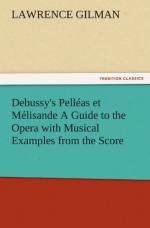ACT I
A brief orchestral prelude, less than twenty measures in length, introduces the opening scene of the first act. Divided and muted ’cellos, double-basses, and bassoons intone, pp, a solemn and brooding theme[6] designed to evoke the thought of the forest, which, sombre, mysterious, and oppressive, forms the background against which the events of the drama are projected (page 1, measure 1):[7]
[6] Its curious progressions, based on the Dorian mode of the plain-chant (corresponding to a scale of D-minor without accidentals), I have alluded to in a previous chapter.
[7] These indications refer to the arrangement of the score for voices and piano, with French and English text, published by A. Durand & Fils of Paris in 1907. I have indicated in each case, in addition to the page, the measure in which the example begins.
I. THE FOREST [Illustration: Tres modere]
This is immediately followed by one of the most important themes in the opera, that which seems to typify the veiled and overshadowing destiny which is very close to the central thought of Maeterlinck’s play. Strangely harmonized, this Fate theme (it is in the second measure that its kernel is contained, and it is this portion of it that is most frequently repeated) is sounded, pp, tres modere, by oboes, English horn, and clarinets (page 1, measure 5):
II. FATE
[Illustration]
These two themes are repeated, with altered harmonization; then follows one of the two principal themes of the score—that of Melisande, sung, doux et expressif, by the oboe over tremolos in the divided strings (page 1, measure 14):
III. MELISANDE
[Illustration: p doux et expressif]
It is followed by a derivative theme which, in the drama, suggests the naivete of Melisande’s personality (page 1, measure 1):
IV. MELISANDE’S NAIVETE [Illustration]
Flute, oboe and clarinet repeat it over a counterpoint formed by the Fate theme (2 horns), and the curtain opens to the accompaniment of the Forest motive. This latter theme, with the motive of Fate, underscores the earlier portions of the dialogue between Golaud and Melisande. At Golaud’s words: “Oh! you are beautiful!” we hear (page 7, measure 1) an ardent phrase in the strings expressive of his awakened passion for the distressful little princess:
V. GOLAUD’S LOVE
[Illustration: Animee]
This theme is sounded again, with peculiarly penetrating effect, in the divided strings, as Golaud entreats Melisande not “to weep so” (page 9, measure 4), and, later in the scene (page 19, measure 1), when he tells her that she must not stay in the forest alone after nightfall, and urges her to go with him. As he informs her that he is “Prince Golaud, grandson of Arkel, the aged king of Allemonde,” we hear, on the bassoons and horns, his own motive (page 14, measure 8):




